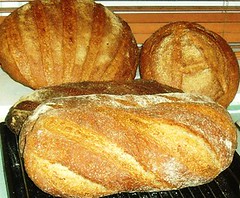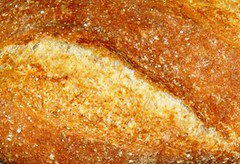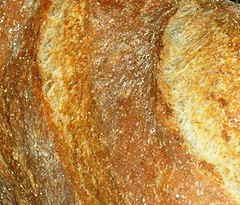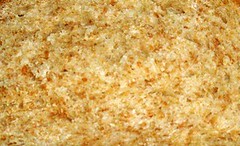

Finally I find time to post. It's been a busy festive season, with a mamoth baking session on Boxing Day, and a smaller one today. To the detail, beginning with pre-ferments for the initial large bake.
RYE SOUR DOUGH
Stock Sour 288g [D. Rye Flour 108; Water 180] Saturday 18:00
1. Rye Sourdough 288
D. Rye Flour 292 [+ 108 = 400 TOTAL]
Water 220 [+ 180 = 400 TOTAL]
TOTAL 800 mixed Sunday 10:00
2. Rye Sourdough 800
D. Rye Flour 330 [+ 400 = 730 TOTAL]
Water 330 [+ 400 = 730 TOTAL]
TOTAL 1460g mixed Sunday 20:00
“SCALD”, or “ZAVARKHA”
Bacheldre Organic Dark Rye Flour | 300 |
Red Malted Barley Powder | 100 |
Boiling Water | 700 |
TOTAL | 1100 |
PÂTE FERMENTÉE
Wholemeal Bread Flour 500
Salt 10
Butter 10
Fresh Yeast 10
Water 340
TOTAL 870g
mixed Sunday 19:00, fermented 1 hour, then retarded overnight
WHEAT LEVAIN
1.Stock Levain 216 [Bread Flour 135; Water 81] Saturday 18:00
Bread Flour 300 [+ 135 = 435 TOTAL]
Water 180 [+ 81 = 261 TOTAL]
TOTAL 696 mixed Sunday 10:00
2.Levain 696
Bread Flour 600 [+ 435 = 1035 TOTAL]
Water 360 [+ 261 = 621 TOTAL]
TOTAL 1656 mixed Sunday 14:00
FLAX SEED SOAKER
Flax Seed Blond 200
Cold Water 600
TOTAL 800 mixed Sunday 10:00
“POOLISH”
Bread Flour 840g
Fresh Yeast 003g
Water 840g
TOTAL 1683g [use 561g for Croissant Dough and 1122g for Bloomers]
mix Sunday 20:00
BIGA
Bread Flour 400
Water 240
Fresh Yeast 002
TOTAL 642g mixed Sunday 19:30
The first six of these were all made on Monday 26th December using a combination of both wood-fired brick oven and electric oven to complete the baking. A Christmas Marathon, totalling 25 loaves, plus a range of laminated pastries! Sorry, there are no photographs from this bake; I was just too busy trying to cope with the hectic schedule preparing for family visiting etc.
1. Sourdough Seed Bread with Wheat Levain, Wholemeal Flour, Roasted Seeds and a Cold Flax Seed Soaker
For the levain build and cold soaker, see above.
Material/Stage | Formula [% of flour] | Recipe [grams] |
1a. Wheat Levain | | |
Marriage’s Organic Strong White Flour | 25 | 1000 |
Water | 15 | 600 |
TOTAL | 40 | 1600 |
| | |
1b. Cold Soaker | | |
Flax Seed Blond | 5 | 200 |
Water | 15 | 600 |
TOTAL | 20 | 800 |
| | |
1c. Roasted Seeds | | |
Pumpkin Seeds | 5 | 200 |
Sunflower Seeds | 5 | 200 |
Pumpkin, Sunflower, Hemp, Flax, Sesame | 1.5 | 60 |
Japanese Organic Tamari Soy Sauce | To Taste | |
TOTAL | 11.5 | 460 |
| | |
2. Final Dough | | |
Wheat Levain [from 1a] | 40 | 1600 |
Cold Soaker [from 1b] | 20 | 800 |
Roasted Seeds [from 1c] | 11.5 | 460 |
Marriage’s Organic Strong White Flour | 35 | 1400 |
Marriage’s Organic Strong Wholemeal | 40 | 1600 |
Salt | 1.8 | 72 |
Water | 48 | 1920 |
TOTAL | 196.3 | 7852 |
| | |
% pre-fermented flour | 25 | - |
% overall hydration | 78 | 68.67flour+seeds |
% wholegrain flour | 40 | - |
% of seeds on flour | 16.5 | - |
FACTOR | 40 | - |
Method:
- Build the levain as above, and prepare the cold soaker.
- Roast the Seeds under the grill with tamari to taste; turn as needed. Cool.
- Prepare an autolyse with both flours plus water for the final dough. Leave 1 hour to stand.
- Add the salt, leaven and soaker and mix on first speed for 5 minutes, scraping down as needed, and adjusting the hydration if necessary. Mix for 3 minutes on second speed, then scrape down and check development. Add the roasted seeds and mix on first speed until cleared.
- Retard the dough overnight.
- Bulk proof for 1 hour to return the dough to 26°C.
- Scale and divide. Mould each dough piece round, and rest whilst preparing bannetons. I made 9 various sized boules from this dough.
- Re-mould, then prove upside down in bannetons for 3 hours
- Turn each loaf onto a peel, score the top, then set to bake in the wood-fired oven.
- Cool on wires.
2. 100% Wholemeal Panned Breads made with Pâte Fermentée
For the Pâte Fermentée schedule, see above
Material/Stage | Formula [% of flour] | Recipe [grams] |
1. Pâte Fermentée | | |
Marriage’s Organic Strong Wholemeal | 25 | 500 |
Salt | 0.5 | 10 |
Butter | 0.5 | 10 |
Fresh Yeast | 0.5 | 10 |
Water | 17 | 340 |
TOTAL | 43.5 | 870 |
| | |
2. Final Dough | | |
Pâte Fermentée [from 1] | 43.5 | 870 |
Marriage’s Organic Strong Wholemeal | 75 | 1500 |
Salt | 1.3 | 26 |
Butter | 1.3 | 26 |
Fresh Yeast | 2 | 40 |
Water | 55 | 1100 |
TOTAL | 178.1 | 3562 |
| | |
% overall pre-fermented flour | 25 | - |
% overall hydration | 72 | - |
% wholegrain flour | 100 | - |
FACTOR | 20 | - |
Method:
- As described above, for the Pâte Fermentée, combine all the ingredients in a mixer, and mix on first speed for 5 minutes, scraping down as needed. Mix a further 2 – 4 minutes on second speed. Bulk ferment for 2 hours, then retard overnight.
- To mix the final dough, firstly autolyse flour and water for 1 hour. Then add the Pâte Fermentée and the other ingredients and mix for 2 minutes on first speed. Scrape down and mix for 7 minutes on second speed. DDT 28°C
- Bulk ferment 40 – 50 minutes at 28°C
- Scale, divide and mould round. Rest covered for 10 - 15 minutes and prepare bread pans. Shape dough pieces and place into pans. I made 3 different-sized panned loaves, plus 1 bloomer.
- Final proof 2 hours at 28°C.
- Bake in the wood-fired oven.
- Cool on wires.
3. Bloomers made with a “Poolish” and Rye Sourdough
For the schedules for both the “Poolish” and the Rye Sourdough, see above.
Material/Stage | Formula [% of flour] | Recipe [grams] |
1a. Rye Sourdough | | |
Bacheldre Organic Dark Rye Flour | 5 | 100 |
Water | 5 | 100 |
TOTAL | 10 | 200 |
| | |
1b. “Poolish” | | |
Marriage’s Organic Strong White Flour | 28 | 560 |
Water | 28 | 560 |
Fresh Yeast | 0.1 | 2 |
TOTAL | 56.1 | 1122 |
| | |
2. Final Dough | | |
Rye Sourdough [from 1a] | 10 | 200 |
“Poolish” [from 1b] | 56.1 | 1122 |
Marriage’s Organic Strong White Flour | 67 | 1340 |
Salt | 1.8 | 36 |
Fresh Yeast | 2.5 | 50 |
Water | 30 | 600 |
TOTAL | 167.4 | 3348 |
| | |
% pre-fermented flour | 33 | - |
% overall hydration | 63 | - |
% wholegrain flour | 5 | - |
FACTOR | 20 | - |
Method:
- Build levain and “poolish” as above.
- Combine both pre-ferments with all the other ingredients for the final dough in a mixer. Mix with the hook attachment on first speed for 3 minutes, scraping down as needed and making any necessary adjustment to hydration. Mix a further 4 – 5 minutes on second speed to develop. DDT 26°C.
- Bulk proof 50 minutes @ 26°C.
- Scale and divide and mould round. Rest covered and prepare baking sheets. Shape for bloomers and tray up. I made 3 large bloomers.
- Final proof @ 28°C for 2 hours.
- Cut the tops of the loaves with 3 diagonal slashes, spray with water, and bake on the sole of the wood-fired oven.
- Cool on wires.
4. Ciabatta with a “Biga”
For the “Biga”, see schedule above
Material/Stage | Formula [% of flour] | Recipe [grams] |
1. “Biga” | | |
Marriage’s Organic Strong White Flour | 40 | 400 |
Fresh Yeast | 0.2 | 2 |
Water | 24 | 240 |
TOTAL | 64.2 | 642 |
| | |
2a. Final Dough – “Bassinage” | | |
“Biga” [from 1] | 64.2 | 642 |
Gilchesters’ Organic Ciabatta/Pizza Flour | 60 | 600 |
Salt | 1.8 | 18 |
Fresh Yeast | 2 | 20 |
Water | 44 | 440 |
TOTAL | 172 | 1720 |
| | |
2b. Final Dough – Wet Stage | | |
Final Dough – “Bassinage” | 172 | 1720 |
Water | 12 – 17 | 120 – 170 |
TOTAL | 184 - 189 | 1840 - 1890 |
| | |
% pre-fermented flour | 40 | - |
% overall hydration | 80 – 85 | - |
FACTOR | 10 | - |
Method:
- Prepare the biga as above.
- For the bassinage, add all ingredients to the mixer, attach a dough hook and mix on first speed for 3 minutes, scraping down as needed. Mix a further 3 minutes on second speed. For the final stage, change to a paddle beater and let the down down to required wet consistency on first and second speeds. Scrape down as needed. Final DDT 26°C
- Line a container with some olive oil, and pour the wet dough into the container. Cover and hold at 26°C for 2 hours, using stretch and fold after a ½, 1 and 1½ hours.
- Move to the “dry” stage and scale and divide dough pieces using a combination of Gilchesters’ flour and Coarse Semolina. I made 6 ciabatta breads.
- Final proof for up to 1 hour.
- Bake on the sole of a hot wood-fired oven.
- Cool on wires.
5. “Rossisky” using the Auerman Method
See above for Rye Sourdough Build
Material/Stage | Formula [% of flour] | Recipe [grams] |
1a. Rye Sourdough | | |
Bacheldre Organic Dark Rye Flour | 30 | 600 |
Water | 30 | 600 |
TOTAL | 60 | 1200 |
| | |
1b. “Scald” | | |
Bacheldre Organic Dark Rye Flour | 15 | 300 |
Red Malted Barley Powder | 5 | 100 |
Boiling Water | 35 | 700 |
TOTAL | 55 | 1100 |
| | |
2. “Sponge” | | |
Rye Sourdough [from 1a.] | 60 | 1200 |
“Scald” [from 1b.] | 55 | 1100 |
TOTAL | 115 | 2300 |
| | |
3. Final Paste | | |
“Sponge” [from 2] | 115 | 2300 |
Bacheldre Organic Dark Rye –finely sifted | 30 | 600 |
Gilchesters’ Organic Pizza/Ciabatta Flour | 20 | 400 |
Water | 20 | 400 |
Salt | 1.5 | 30 |
TOTAL | 186.5 | 3730 |
| | |
% pre-fermented flour | 30 + 20 = 50 | - |
% overall hydration | 85 | - |
FACTOR | 20 | - |
Method:
- Build the sour as described, make the Scald, then combine the 2 to make the Sponge. Ferment this for 4 hours.
- I sifted through the Bacheldre Organic Dark Rye flour, reserving the fine flour to use here Add the Gilchesters’ Pizza flour to this, plus the water and autolyse for 1 hour. Add the salt and the sponge to the autolyse in a mixer, and combine with the paddle beater to form a paste.
- Bulk proof for 1 hour.
- Line a Pullman Pan and other bread pans neatly with silicone paper and scale the paste into the pans, neatening off carefully. Attach lids.
- Final Proof 3 hours. Bake overnight in the “dead” wood-fired oven. Sadly, these did not work, as the oven was just too dead, so the loaves did not bake out. I made a half batch again today and scaled the whole mixture into one large Pullman Pan.
6.Croissant Dough with a “Poolish” [See the “Poolish” schedule above]
Material/Stage | Formula [% of flour] | Recipe [grams] |
1. “Poolish” | | |
Marriage’s Organic Strong White Flour | 28 | 280 |
Fresh Yeast | 0.1 | 1 |
Water | 28 | 280 |
TOTAL | 56.1 | 561 |
| | |
2. “Détrempe” | | |
“Poolish” [from 1] | 56.1 | 561 |
Marriage’s Organic Strong White Flour | 72 | 720 |
Chilled Water | 32 | 320 |
Salt | 1.2 | 12 |
Milk Powder | 5 | 50 |
Fresh Yeast | 5 | 50 |
Caster Sugar | 8 | 80 |
TOTAL | 179.3 | 1793 |
| | |
3. Lamination | | |
Détrempe [from 2] | 179.3 | 1793 |
Organic Slightly Salted Butter | 41.6 | 416 |
TOTAL | 220.9 | 2209 |
| | |
% pre-fermented flour | 28 | - |
% hydration | 60 | - |
% fat on flour | 41.6 | - |
FACTOR | 10 | - |
Method:
- Mix the “poolish” as above, and leave to ferment overnight. Chill both the flour and water for the final dough in the fridge overnight.
- Combine all the ingredients for the final dough in the mixer. Attach a dough hook and mix on first speed for 4 minutes, scraping down and adjusting the hydration as necessary. Develop the dough on second speed for 3 minutes.
- Retard the dough for 1 hour.
- Incorporate the laminating fat using the English method. Retard 1 hour.
- Give 4 half turns to the dough with 1 hour rest between each turn, in the chiller.
- Process as required. I used the pastry dough to make a Chestnut loaf for Christmas Dinner with my family, plus a selection of croissants, pains au chocolat. I made “Palmiers” with the scrap dough.
- Prove finished pieces for 45 minutes and bake in the electric oven using a convection setting at 210°C.
- Cool on wires.
7. Bloomers made with a “Poolish” and Rye Sourdough and Wholemeal
For the schedules for both the “Poolish” and the Rye Sourdough, see above.
Material/Stage | Formula [% of flour] | Recipe [grams] |
1a. Rye Sourdough | | |
Bacheldre Organic Dark Rye Flour | 5 | 130 |
Water | 5 | 130 |
TOTAL | 10 | 260 |
| | |
1b. “Poolish” | | |
Marriage’s Organic Strong White Flour | 28 | 728 |
Water | 28 | 728 |
Fresh Yeast | 0.1 | 2.6 |
TOTAL | 56.1 | 1458.6 |
| | |
2. Final Dough | | |
Rye Sourdough [from 1a] | 10 | 260 |
“Poolish” [from 1b] | 56.1 | 1458.6 |
Marriage’s Organic Strong White Flour | 22 | 572 |
Marriage’s Organic Strong Wholemeal | 45 | 1170 |
Salt | 1.8 | 46.8 |
Fresh Yeast | 2.55 | 65 |
Water | 34.05 | 885.3 |
TOTAL | 167.4 | 4457.7 |
| | |
% pre-fermented flour | 33 | - |
% overall hydration | 67.05 | - |
% wholegrain flour | 50 | - |
FACTOR | 26 | - |
Method:
- Build levain and “poolish” as above.
- Combine both pre-ferments with all the other ingredients for the final dough in a mixer. Mix with the hook attachment on first speed for 3 minutes, scraping down as needed and making any necessary adjustment to hydration. Mix a further 4 – 5 minutes on second speed to develop. DDT 26°C.
- Bulk proof 50 minutes @ 26°C.
- Scale and divide and mould round. Rest covered and prepare baking sheets. Shape for bloomers and tray up.
- Final proof @ 28°C for 2 hours.
- Cut the tops of the loaves with 3 diagonal slashes, spray with water, and bake on the sole of the wood-fired oven.
- Cool on wires.
Photos from today’s baking shown below:






A Very Happy New Year to you all!
Andy